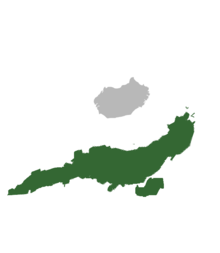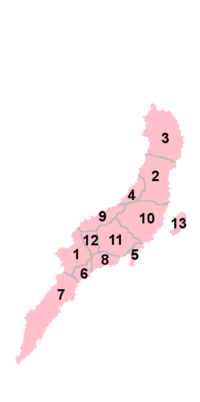Nation/Narsora
| This page is a work in progress by its author(s) and should not be considered final. |
| The Republic of Narsora República de Narsora (Spanish)
|
|||||
|---|---|---|---|---|---|
|
|||||
| Motto: "Peace,Freedom and Compassion" | |||||
| Region | The South Pacific | ||||
| Capital and largest city | Narsora City | ||||
| Official languages | Spanish , Indigenous Languages | ||||
| Recognised national languages | English | ||||
| Ethnic groups | * 46.3% White
|
||||
| Demonym | Narsoran | ||||
| Government | Unitary, Presidential, Republic | ||||
| - | President | María Castellano (NDP) | |||
| - | Vice President | Antonio Peña (NDP) | |||
| - | President of the National Congress | Takashi Cayetano (CP) | |||
| Legislature | National Congress | ||||
| - | Upper house | Senate | |||
| - | Lower house | Chamber of Deputies | |||
| Independence | |||||
| - | from Spain | June 22, 1957 | |||
| - | Republic | June 22, 1960 - Present | |||
| Area | |||||
| - | Total | 379,200 km2 146,409 sq mi |
|||
| Population | |||||
| - | 2019 estimate | 28,839,283 | |||
| - | Density | 76.05/km2 196.97/sq mi |
|||
| GDP (PPP) | 2019 estimate | ||||
| - | Total | $1.259 trillion | |||
| - | Per capita | $46,344 | |||
| GDP (nominal) | 2019 estimate | ||||
| - | Total | $629.613 billion | |||
| - | Per capita | $25,463 | |||
| Gini (2017) | medium |
||||
| HDI (2017) | very high |
||||
| Currency | Narsoran Dollar ($NRD) |
||||
| Time zone | Narsora Standard Time (NST) (UTC+ 4:00) | ||||
| Date format | mm/dd/yyyy | ||||
| Calling code | +693 | ||||
| Internet TLD | .nar | ||||
The Republic of Narsora is an island nation in The South Pacific. The 2019 population estimates the country's population at roughly 28,582,044 . The country was formed in June 1957 after a peaceful independence from the Kingdom of Spain . Despite this, the nation formally celebrated it's independence on the same day in 1960 and continues to on June 22nd of each year. The country is classified as a unitary-presidental republic, headed by a president whom is elected via direct election with a "two-round" or "run-off" plurality system used if no candidate receives over 50% of votes.
Geography
Narsora has variety of geological areas; while most of the country is urbanized, some areas in the southern provinces have densities as low as 12.76 persons per square mile.
Climate
The country has a has a Tropical rainforest climate (Cfa according to the Köppen climate classification). Average temperatures range from 80°F in January to 59°F in August.
History
Early History
Historical evidence shows that humans have lived in the area now known as Narsora for as long 15,000 years ago. As the geographical location of the island is relativlity remote, only four seprate Native American tribes are known to exist; the Ipópopó, Tomucúlan, Bolñukon & Tirbirio.
Spanish Colonization
Due to the islands relative remoteness, treacherous waters and hostile natives, the first spanish explorers didn't reach the island until 1702. When a spanish armada managed to land on the island, the resulting death toll has been estimated between 5,000-10,000 from disease and warfare combined. During spanish rule especially through the early 20th century, the territory became one of the wealthiest in the Spanish Empire. During the Spanish Civil War, narsoran based military garrisons supported the coup. Spanish rule lasted around 255 years, and the island was one of the last territories to be granted independence; in 1957.
Modern History
Narsora was granted independence by Spain in 1957 following international pressure, but was not recognized as a soverign state until June 23, 1960 as the constitution was being written. In 1969 Torisakia laid claim to the González Archipelago, a set of islands off the western coast of Narsora. Claiming that the islands had been given to them by former colonial ruler the United Kingdom, for use as an overseas military post in 1962, narsoran leadership ignored the country's demands as did a majority of the international community. In July, 1973 Torisakian military forces annexed the island chain from Narsora, causing a now 49 year dispute that has (as of April 2018) left 322 dead and 700 wounded, mostly civilians.
21-O Revolution
In 1984 following the increasingly authoritarian policies of then president David Anderson and a deteriorating economy, protesters began calling for his resignation. Following a year of continued protests, on October 23rd 1985, the Narsoran Congress approved the impeachment process for Anderson. The same day, as news spread 10,000 protesters gathered at the Palacio de Gobierno to demand he leave immediately, and the Presidential Guard (Narsora) surrounded the outside of the building to disperse the protesters. No exact account of the events that followed can be found, but Guardsmen opened fire on the crowd and killed 20 people and injured 65. As President Anderson defied Congress's ruling and refused to resign and due to what became known as the San Marcos Massacre, control of the country was handed over to the National Congress as per the constitution and the National Army was authorized to forcefully remove Anderson from office. On October 24th, 10,000 troops entered the capital and confronted Presidential Guardsmen in front of the palace demanding initiating a standoff which lasted for two hours and nearly brought the country to civil war, eventually the guardsmen stood down and two dozen troops entered the palace and detained Anderson. In 1995, October 21st was declared a national holiday as Día de la Revolución (English: Revolution Day).
Recent History
Beginning in 2008 along with many others, the country slipped into recession with the unemployment rate reaching 11.3% in mid-2010. On February 13th, 2009 a massive car bomb exploded in the Centro Internacional de Negocios (International Business District) of the capital Narsora City, killing 32 and injuring 228. A Ipópopó-based separatist group, the IMAB claimed responsibility and declared they would continue their insurgency until the government granted independence to the province of Alta Bahía. When the government authorized the military to hunt down and dismantle the group the five year long Insurgency in Narsora began, which over it's course cost the lives of 1,800 people and long term damage to the province of Alta Bahía.
Government and politics
The current constitution Narsora was approved via national plebiscite in July 1960 and went into effect January 1961. It is classified as a unitary-presidental republic, headed by headed by a president whom is elected via direct election with a "two-round" or "run-off" plurality system used if no candidate receives over 50% of votes. The National Congress of Narsora has a 150-seat Senate and a 150-member Chamber of Deputies. Senators serve and are elected every four years as are deputies. The last congressional elections were held on 6 October 2014, concurrently with the presidential election. The current congressional body is split 150-110-40-10 favoring the majority New Democratic Party . On November 26th 2018, María Castellano became the first woman to be directly elected president of the country.
Foreign Relations
Main article:Foreign Relations of Narsora
Narsora maintains strong relations with most countries although since 1973, relations with the country of Torisakia have been strained. chiefly over a disputed chain of islands known as the González Archipelago.
Administrative Divisions
In 1960 Narsora was divided into 10 provinces which increased to three in 1992, 1999 and 2006, which were further divided into 392 (as of 2018) municipalities (spanish: Municipios).
There are 12 provinces in mainland Narsora and 1 island province:
|
The population spread between the various provinces differ widely, between Miralosa province, which contains the country's capital Narsora City with 8.7 million to 6,786 in the province of Patariki.
Human Rights
Narsora has generally respected human rights in it's 55-year history. Although several incidences in the 1970's garnered widespread condemnation. Of continued concern is the country's treatment of Torisakian immigrants and tourists and known or suspected terrorists.
Military
The armed forces of Narsora are known as the Narsoran National Military, and numbered around 107,000 in 2018.
Law & Crime
The national civilian police force is the Narsoran National Police. The intentional homicide rate for the country in 2017 was 1.51 per 100,000.
Demographics
Main article: Demographics of Narsora
Narsora has a highly multi-ethnic population mostly comprised of;
- 46.3% White Latin American
- 40.5% Mestizo
- 2.2% Afro-Narsoran
- 1.8 Asian Narsoran
- 6.5% Indigenous Peoples
- 2.7% Other (includes foreigners)
The country's increasing standards of living, prosperity and low rates of crime have begun attracting more and more foreign immigrants since the beginning of the 21st century.
Religion
Main article: Religion in Narsora
Narsora enjoys full religious freedom and as a result, is an exceptionally diverse country in religious beliefs; the major religions are
- Protestantism at 25%
- Catholicism at 50%
- Other religions eg.Buddhism, Islam & Judaism at 5%.
The percentage of the population that claim to be Atheists is estimated at 20% as of 2017.
Langauges
Narsora has five official languages; Spanish, and the four indigenous languages, Ytobüŋan, Ipópopó, Agsèkhi and Tomucúlan. Important signage is translated into the language appropriate to the region one is located in. English, while not an official language is a national language, as it is used in many business situations and is a required subject taught to schoolchildren. The country also has one of the highest English-language proficiency ratings in the region at 62.48 as of 2018.
Education
In Narsora, education consists of Primary, Secondary and Post-secondary education. Beginning with preschool until the age of 5, primary school for children between ages 6 and 13 and secondary school until graduation at age 17-18.
As in many countries, Secondary education is divided into two parts: During the first two years, students receive a general education. Then, they may choose a branch: scientific humanistic education, artistic education, or technical and professional education. A process to streamline this level of schooling was put into effect in 2000, in which both levels of secondary schooling are housed in one location/building. Secondary education lasts a total of four years and ends upon the acquirement of a certificate known as a Licencia de Educación Básica (License of Basic Education).
All education up to post-secondary is provided free of charge to citizens by the government. 90% of funding comes from the federal government while the remaining 10% is funded by local governments.
The National University of Narsora is the largest and oldest university in the country, founded in 1909 during colonial rule and a total enrollment of around 45,278 as of 2018.
Upon successful graduation of secondary school, students may continue into higher education. The higher education schools consist of traditional Universities and are divided into public universities or private universities. Both the National University of Narsora (Universidad Nacional de Narsora) and Manzulo University of Science & Technology (Universidad de Ciencia y Tecnología de Manzulo) are medical schools. Both also being the only medical centers in the country able to treat major traumatic injuries.
Health
The Ministry of Health is the cabinet-level administrative office in charge of planning, directing, coordinating, executing, controlling and informing the public of the health policies formulated by the state. The average life expectancy in Narsora at birth is 80.1 years (77.3 years for males and 83.1 years for females).
In a 2017 study, the Narsoran healthcare system was ranked in the top 5% in the region and 6% in world.




